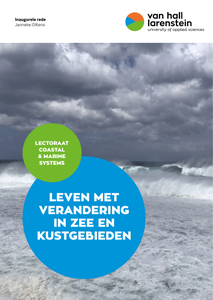DOCUMENT

Met dit opdrachtenboek wordt een brug geslagen tussen het onderwijs en externe bedrijven met onderzoeksvragen. In deze tweede versie van het Innovatiewerkplaats-opdrachtenboek in het kader van het Innovatiewerkplaats/Krachtig MKB van het Kenniscentrum Biobased Economy (KC BBE) en het Instituut voor Life Sciences & Technology (ILST) vindt u ILST-gerelateerde opdrachten voor de ILST-(honours)student of docent-onderzoeker. Deze opdrachten zijn geacquireerd in samenwerking met de Gebiedscoöperatie Westerkwartier en de Gebiedscoöperatie Oost-Groningen (i.o.); ‘opgehaald’ tijdens het door het KC BBE georganiseerde grassymposium en als kennisvraag ontstaan door eerdere verrichte onderzoeken vanuit het Innovatiewerkplaats-gebeuren.
DOCUMENT

Dit document vertelt niet alleen het verhaal van een duurzame toekomst, maar vertaalt ook de experimenten uit de ZuidHollandse ‘proeftuinen’ naar een aantal lessen die ons kunnen helpen om die toekomstbeelden dichterbij te brengen. Uit dit verhaal blijkt ook dat er nog grote stappen gezet moeten worden om die transitie te realiseren. Hier ligt een belangrijke taak voor de overheid. Het actief uit de weg ruimen van tegenwerkende wet- en regelgeving hoort hierbij, maar ook het scheppen van ruimte voor ondernemers en boeren die vastzitten in het huidige systeem. De richting is uitgestippeld, nu is het aan ons om allemaal de transitie in de volgende versnelling te brengen.
DOCUMENT

Inaugurele rede uitgesproken bij de aanvaarding van het ambt van lector aan Hogeschool Van Hall Larenstein, 17 november 2025. In haar inaugurele rede schetst Janneke Ottens hoe een systeembenadering, aandacht voor veerkracht en een andere omgang met natuurlijke dynamiek ons kunnen helpen om beter voorbereid te zijn op de gevolgen van klimaatverandering. Ze benadrukt het belang van samenwerking met regionale partners, van het Waddengebied tot het Caribisch deel van het Koninkrijk, om ecosystemen én gemeenschappen toekomstbestendig te maken. Het lectoraat Coastal & Marine Systems richt zich op praktijkgericht onderzoek dat helpt om natuur, economie en samenleving in kust- en zeegebieden in balans te brengen. Daarbij werkt HVHL intensief samen met Deltares, het Werelderfgoedcentrum Waddenzee, Springtij en een breed netwerk van overheden, bedrijven, vissers, natuurorganisaties en kennisinstellingen.
DOCUMENT

Micro and macro algae are a rich source of lipids, proteins and carbohydrates, but also of secondary metabolites like phytosterols. Phytosterols have important health effects such as prevention of cardiovascular diseases. Global phytosterol market size was estimated at USD 709.7 million in 2019 and is expected to grow with a CAGR of 8.7% until 2027. Growing adoption of healthy lifestyle has bolstered demand for nutraceutical products. This is expected to be a major factor driving demand for phytosterols. Residues from algae are found in algae farming and processing, are found as beachings and are pruning residues from underwater Giant Kelp forests. Large amounts of brown seaweed beaches in the province of Zeeland and are discarded as waste. Pruning residues from Giant Kelp Forests harvests for the Namibian coast provide large amounts of biomass. ALGOL project considers all these biomass residues as raw material for added value creation. The ALGOL feasibility project will develop and evaluate green technologies for phytosterol extraction from algae biomass in a biocascading approach. Fucosterol is chosen because of its high added value, whereas lipids, protein and carbohydrates are lower in value and will hence be evaluated in follow-up projects. ALGOL will develop subcritical water, supercritical CO2 with modifiers and ethanol extraction technologies and compare these with conventional petroleum-based extractions and asses its technical, economic and environmental feasibility. Prototype nutraceutical/cosmeceutical products will be developed to demonstrate possible applications with fucosterol. A network of Dutch and African partners will supply micro and macro algae biomass, evaluate developed technologies and will prototype products with it, which are relevant to their own business interests. ALGOL project will create added value by taking a biocascading approach where first high-interest components are processed into high added value products as nutraceutical or cosmeceutical.